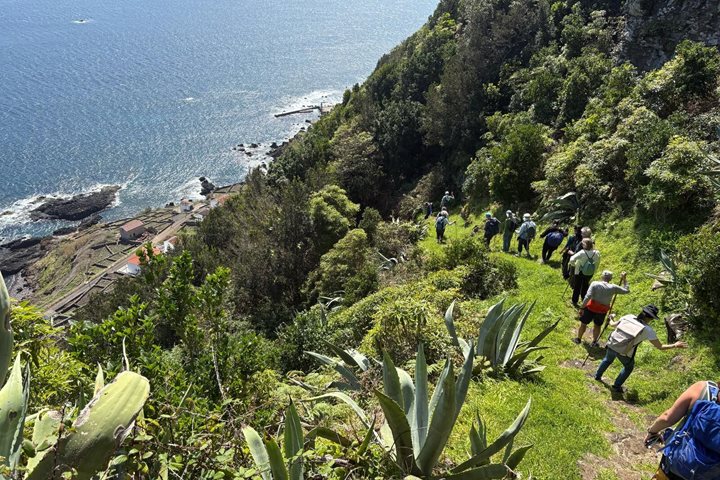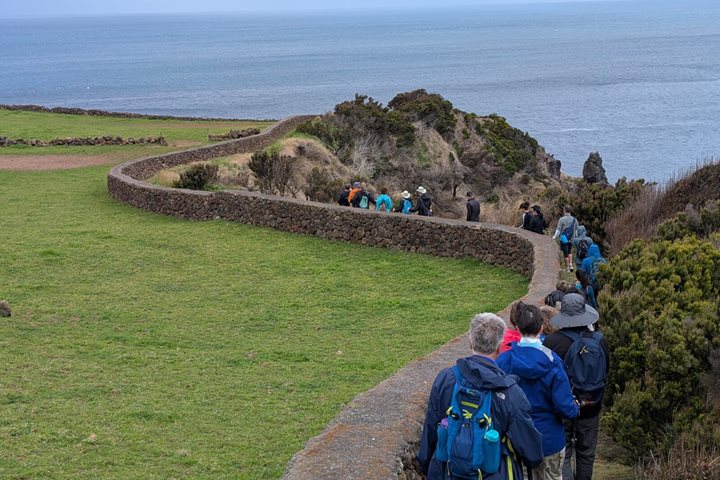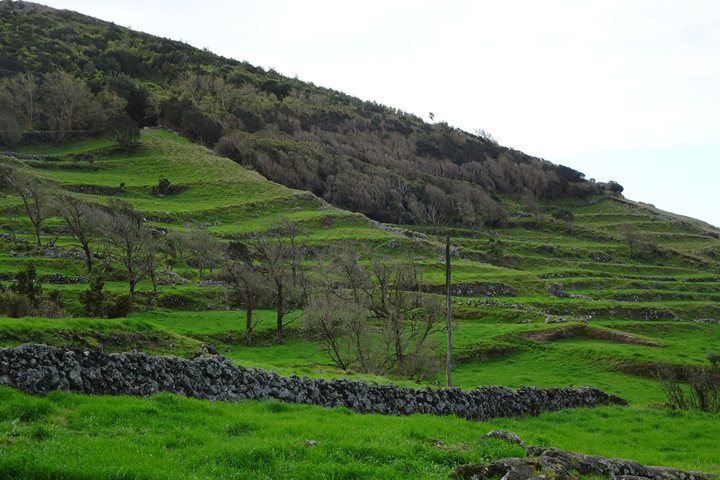Four options offered everyone aboard National Geographic Endurance an opportunity to choose an expedition suited to their interests for exploration of Sao Miguel, the largest island of the Azores. While some guests chose to explore Ponta del Gada on their own, most of us headed off to explore various places on the island.
Three coaches and a van carried all of us from the ship to different destinations on Sao Miguel. One group headed off to the northeast end of the island to explore part of the native laurisilva forest and search for the endangered and endemic priolo, or Azores bullfinch, in the Terras de Priolo Reserve. Others headed directly to Terra Nostra Garden to try swimming in the iron-rich thermal lake.
The rest of us traveled east from the current capital city in two coaches, observing the scenic coast on our way to Villa Franca do Campo, the former capital of the island. En route, we passed many farm fields lined by the now familiar lava rock walls that checkerboard all the Azores. A variety of crops thrived in the numerous enclosed plots, including bananas, taro, corn, and melons. We also spotted dairy cattle.
A large, flat area that is protected from the winds by a mountain, offering good access to the sea, seemed like an ideal site for the capital when Sao Miguel was settled. A landslide destroyed the town in 1522, though. While the town was entirely rebuilt, Villa Franca never regained its status as the capital of Sao Miguel.
Our coach drivers skillfully maneuvered down the town’s narrow, winding cobblestone streets interlacing the white-sided, red-tile roofed homes and buildings characteristic of all the island cities and villages we have visited. Our destination was the picturesque harbor filled with sailboats and a particular local pastry shop, Do Morgado Queijadas de Vila Franca Do Campo. Inside, we watched the preparation of the special pastries through large glass windows. Many of us sampled some of their treats along with small cups of espresso.
From there, we headed farther east to the famed Terra Nostra Garden and its thermal springs. We met up with our fellow travelers who had enjoyed swimming in the warm, iron-red waters of the thermal lake at the edge of the garden. While the swimmers washed off the red hues of the mineral rich water, the rest of us wandered through the gardens along well-manicured, cobblestoned trails. Trees and flowers from all over the world, from New Zealand to China, have been planted here in the 200 years since the gardens were established in 1776. A beautiful new addition to the garden features native and endemic Azores flora, a stark contrast to the garden’s history of featuring plants from far flung lands. We admired and photographed some of the plants growing here, up to one thousand species.
Heading farther east after the garden visit, we stopped briefly at Furnas to observe the unique geothermal cooking method used for our noon meal. As we watched, two strong men pulled up a huge steel pot that had been lowered into a concrete pit in the ground near a steaming, bubbling thermal hot spring. They judged the meal cooked and carried the pot off in a truck to a nearby restaurant.
We soon rejoined our fellow travelers at the restaurant. We enjoyed local wines and a hearty stew of potatoes, taro, carrots, kale, cabbage, and tender beef. This was all topped off by fresh pineapple and pastries from Do Morgado Queijadas. We left fueled for our afternoon activities.
The morning’s swimmers headed off to hike along a trail around Lagos de Furnas. The trail meandered past a beautiful church and through another garden of cultivated trees and flowers. The birding group headed back to Sao Miguel for an afternoon exploring Ponta del Gado. The rest of the group made a visit to the Cha Gorreana tea factory. Here we observed the entire process of tea manufacturing with interpretation by our local guides. Surrounded by hills draped with lush green rows of thriving tea shrubs, the tea processing occurs inside a large white building filled with interesting machinery designed to dry, sort, and process the tea leaves prior to packaging the orange pekoe, black, or green tea.
A scenic trip along the precipitous north and west coast of Sao Miguel took us back to the ship where we ended our day with the Captain’s Farewell Cocktails and a delicious dinner topped off with a decadent chocolate dessert. The night was not yet over, as the Alfredo Gago da Camara performers were aboard to entertain us in the Ice Lounge after dinner. This professional local Fado group features a singer and three musicians who played Portuguese guitar, classical guitar, and bass. It was a fitting end to a full day of exploration.







